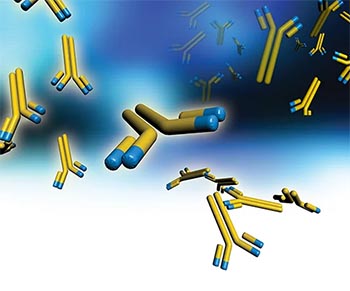
Popular topics

-
References
Alkan SS (2004). Monoclonal antibodies: the story of a discovery that revolutionized science and medicine. Nat Rev Immunol 4, 153-156.
Jerne NK and Nordin AA (1963). Plaque formation in agar by single antibody producing cells. Science 140, 405.
Kohler G and Milstein C (1975). Continuous cultures of fused cells secreting antibody of predefined specificity. Nature 256, 495.
Milstein C (1985). From the structure of antibodies to the diversification of the immune response. EMBO J 4, 1083-1092.
Wade N (1980a). Inventor of hybridoma technology failed to file for patent. Science 208, 693.
Wade N (1980b). Hybridomas: A potent new biotechnology. Science 208, 692.
Journey to the antibody vial: the story of monoclonal antibodies in research

Monoclonal antibodies are necessary tools for major life science research applications such as Flow Cytometry, Western Blotting and Immunofluorescence. For many new graduate students and postdocs, it’s hard to imagine scientific research before their existence. But have you ever wondered how these proteins came to be available to you at the click of a few buttons? Join us as we take a walk down memory lane and tell the story of the journey to the antibody vial.
The story really begins in the 19th century when antibodies were first discovered. In 1890, Emil Von Behring and Kitasato Shibasaburo demonstrated that neutralizing antibodies in the blood of patients could combat certain pathogen-mediated diseases. This led to continued research on antibodies, and by the 1960s scientists had made great strides in further understanding how antibodies worked (Alkan, 2004), yet several questions remained. For instance, the molecular mechanisms of antibody diversity were not fully understood. This was to be the main focus of our protagonist César Milstein when he arrived at the Laboratory of Molecular Biology in Cambridge, England in 1963.
Myeloma cells helped unlock the mystery
Milstein was keen on understanding antibody diversity and somatic mutation, and thought the key to solving this mystery was to determine the molecular structures of different antibodies (Alkan, 2004). This led him to explore the possibility of generating a source of antibodies of clearly defined specificity… monoclonal antibodies. Milstein initially utilized myeloma cells (transformed B-cells) as a starting point since they were known to secrete only one type of antibody. The Milstein lab eventually generated myeloma-myeloma fusions that secreted different or hybrid antibodies, but the specificity was not known (Milstein, 1985). Using these myeloma hybrid cells, Milstein and his then post-doctoral fellow George Köhler eventually developed a method of generating cells that indefinitely produced antibodies of known specificity. These cells were referred to as hybridomas, and the method as hybridoma technology. Köhler generated the first monoclonal antibodies against sheep red blood cells (SRBC), which were confirmed using a plaque assay (Jerne, 1963). In 1975, Milstein and Köhler published the technique in the journal Nature (Köhler and Milstein, 1975).
A technique that revolutionalized science
It is clear now that this technique was a remarkable finding that would revolutionize how life science research is performed and ultimately impact the treatment of devastating diseases. However, at the time, some scientists were not convinced of the importance of this tool (Wade 1980a). In fact, neither Milstein nor his institution filed a patent for the technique, demonstrating a failure to recognize its commercial value (Wade 1980a). Milstein did however freely pass on myeloma cells to scientists who requested them, and asked the recipients not to patent any hybridomas created using the cells. Yet, two patents describing use of the hybridoma technology for generating monoclonal antibodies to tumors and viral antigens were granted in 1979 and 1980 to Hilary Koprowski and other scientists at the Wistar Institute of Philadelphia (Wade, 1980a). Controversy arose as to whether Milstein had clearly indicated his request not to patent to Kaprowski when he sent him his myeloma cells (Wade, 1980a). Although they do not hold a patent to the technology, Milstein and Köhler are widely acknowledged as the inventors of the hybridoma technique.
By 1980, just five years after Milstein and Kohler published the hybridoma technique, there were five companies in the United States devoted specifically to monoclonal antibodies (Wade, 1980b). Hybritech in La Jolla California, founded in 1978, launched its first hybridoma product in 1979. In the United Kingdom, a company called Sera Lab was the only company selling hybridomas and monoclonal antibodies to scientists during this time period (Wade, 1980b). Today, there are over 300 globally located antibody vendors that sell antibodies and their related products for research purposes. For 35 years, Bio-Rad under the brand AbD Serotec has been one of the world leaders in antibody production, and continues to offer a wide range of catalog antibodies, kits and accessories to scientific researchers.
So now that you know the story, we hope you say a silent thank you to Milstein and all the other scientists involved the next time you open the package containing your monoclonal antibody.
For more information, visit the Medical Research Council’s exhibition: the story of César Milstein and monoclonal antibodies.
References
Alkan SS (2004). Monoclonal antibodies: the story of a discovery that revolutionized science and medicine. Nat Rev Immunol 4, 153-156.
Jerne NK and Nordin AA (1963). Plaque formation in agar by single antibody producing cells. Science 140, 405.
Kohler G and Milstein C (1975). Continuous cultures of fused cells secreting antibody of predefined specificity. Nature 256, 495.
Milstein C (1985). From the structure of antibodies to the diversification of the immune response. EMBO J 4, 1083-1092.
Wade N (1980a). Inventor of hybridoma technology failed to file for patent. Science 208, 693.
Wade N (1980b). Hybridomas: A potent new biotechnology. Science 208, 692.
You may also be interested in...

View more Applications or Feature blogs















